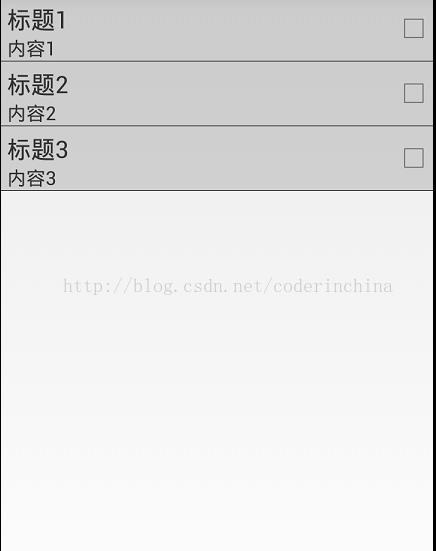android 自己定义组合控件
Posted gcczhongduan
tags:
篇首语:本文由小常识网(cha138.com)小编为大家整理,主要介绍了android 自己定义组合控件相关的知识,希望对你有一定的参考价值。
自己定义控件是一些android程序猿感觉非常难攻破的难点,起码对我来说是这种,可是我们能够在网上找一些好的博客关于自己定义控件好好拿过来学习研究下,多练,多写点也能找到感觉,把一些原理弄懂,今天就讲下自己定义组合控件,这个特别适合在标题栏或者设置界面,看以下图:
就很适合使用组合控件了,如今写一个玩玩:
activity_main.xml
<LinearLayout xmlns:android="http://schemas.android.com/apk/res/android"
xmlns:hy="http://schemas.android.com/apk/res/com.example.customcircle"
xmlns:tools="http://schemas.android.com/tools"
android:layout_width="match_parent"
android:layout_height="match_parent"
android:orientation="vertical"
>
<com.example.customcircle.SettingView
android:id="@+id/sv1"
android:layout_width="fill_parent"
android:layout_height="wrap_content"
hy:title = "标题1"
hy:content = "内容1"
></com.example.customcircle.SettingView>
<com.example.customcircle.SettingView
android:id="@+id/sv2"
android:layout_width="fill_parent"
android:layout_height="wrap_content"
hy:title = "标题2"
hy:content = "内容2"
></com.example.customcircle.SettingView>
<com.example.customcircle.SettingView
android:id="@+id/sv3"
android:layout_width="fill_parent"
android:layout_height="wrap_content"
hy:title = "标题3"
hy:content = "内容3"
></com.example.customcircle.SettingView>
</LinearLayout>SettingView.java
public class SettingView extends RelativeLayout {
private TextView title;
private TextView content;
public SettingView(Context context, AttributeSet attrs, int defStyle) {
super(context, attrs, defStyle);
initView(context);
}
public SettingView(Context context, AttributeSet attrs) {
super(context, attrs);
initView(context);
/**
* 获取一个样式的属性集
* 把布局文件xml中的获取到的样式集合attrs跟自己自己定义的样式集合建立一个映射关系
*/
TypedArray a = context.obtainStyledAttributes(attrs, R.styleable.SettingView);
String title = a.getString(0);
String content = a.getString(1);
//设置到界面上
setTitle(title);
setContent(content);
a.recycle();
}
public SettingView(Context context) {
super(context);
initView(context);
}
private View initView(Context context){
View view = View.inflate(context, R.layout.setting_view, this);
title = (TextView) view.findViewById(R.id.title);
content = (TextView) view.findViewById(R.id.content);
return view;
}
public void setTitle(String tilte){
title.setText(tilte);
}
public void setContent(String strContent){
content.setText(strContent);
}
public void setTextSize(int size){
content.setTextSize(size);
title.setTextSize(size);
}
}
setting_view.xml
<?
xml version="1.0" encoding="utf-8"?>
<LinearLayout xmlns:android="http://schemas.android.com/apk/res/android"
android:layout_width="match_parent"
android:layout_height="wrap_content"
android:orientation="vertical"
android:background="#22000000"
>
<RelativeLayout
android:layout_width="fill_parent"
android:layout_height="wrap_content"
>
<TextView
android:id="@+id/title"
android:layout_width="fill_parent"
android:layout_height="wrap_content"
android:textSize="20sp"
android:layout_marginTop="5dp"
android:layout_marginLeft="5dp"
/>
<TextView
android:id="@+id/content"
android:layout_width="fill_parent"
android:layout_height="wrap_content"
android:textSize="16sp"
android:layout_marginLeft="5dp"
android:layout_below="@id/title"
/>
<CheckBox
android:id="@+id/cb"
android:layout_width="wrap_content"
android:layout_height="wrap_content"
android:layout_alignParentRight="true"
android:layout_centerVertical="true"
/>
</RelativeLayout>
<View
android:layout_width="fill_parent"
android:layout_height="1px"
android:background="#000000"
android:layout_below="@id/cb"
/>
</LinearLayout>
hy:title = "标题1"
hy:content = "内容1"
这个时候xml文件会报错
那是由于android sdk已经声明好了,在找到我们使用的sdk
<!-- Text color. -->
<attr name="textColor" />
<!-- Size of the text. Recommended dimension type for text is "sp" for scaled-pixels (example: 15sp). -->
<attr name="textSize" />
<!-- Style (bold, italic, bolditalic) for the text. -->
<attr name="textStyle" />
<!-- Typeface (normal, sans, serif, monospace) for the text. -->
<attr name="typeface" />
<!-- Color of the text selection highlight. -->
<attr name="textColorHighlight" />
<!-- Color of the hint text. -->
<attr name="textColorHint" />
<!-- Color of the links. -->
<attr name="textColorLink" />
</declare-styleable>
执行效果:

总结下自己定义组合控件的步骤:
1. 写一个类 继承 ViewGroup LinearLayout RelativeLayout
2. 假设在布局文件中面定义view对象 使用这个view对象的两个參数的构造方法.
3. 定义这个自己定义控件里面要显示的内容
View.inflate(context, R.layout.ui_setting_view, this);
4. 加入自己定义控件的属性.
定义自己定义属性的命名空间
5. 声明自己定义的属性
<declare-styleable name="SettingView">
<attr name="title" format="string" />
<attr name="desc_on" format="string" />
<attr name="desc_off" format="string" />
</declare-styleable>
观察R文件 生成 attr内部类 生成styleable 数组 全部的attrs
6. 在xml布局文件中面配置 自己定义的属性.
7. 在自己定义view对象的构造方法里面 获取AttributeSet
跟我们自己定义的属性建立映射关系
8. 在自己定义组合控件里面 设置 布局文件的数据, 扩展点击事件.
9. 在布局文件使用自己定义的view对象.
以上是关于android 自己定义组合控件的主要内容,如果未能解决你的问题,请参考以下文章
